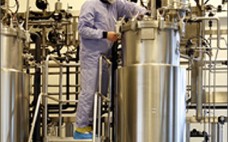Commercial manufacturing of therapeutic monoclonal antibodies (MAbs) commonly uses mammalian cells to generate large quantities of a drug. Identifying cell lines that stably produce high protein titers is, therefore, a critical part of biopharmaceutical development. Unfortunately, identifying suitable cell lines is traditionally a time-consuming, labor-intensive process. That’s because their productivity and stability can vary enormously, so large numbers of clones must be screened to find those with both the highest yield and a desired level of product quality (1). Cell-line…
Manufacturing
A Formulation Strategy for Quickly Reaching Clinical Trials
The aim of any company making protein-based therapeutics is to get to the clinic quickly with a product formulation that has the best chance of success. Any number of specific formulation development and manufacturing issues can keep such drugs from advancing expeditiously to the clinic. To be successful organizations must balance the strengths and weaknesses of each individual molecule against timelines, budgets, and priorities. Ultimately, it’s not just about deploying the best methodologies and processes, but of applying them appropriately…
Strategies for Implementing a BPC in Commercial Biologics Manufacturing
Biopharmaceutical manufacturers use a range of bioprocess containers (BPCs) during the production and storage of biopharmaceuticals. Plastic bags, bottles, flasks, and carboys are all types commonly used in bioprocessing (1). A suitable BPC must be able to maintain aseptic integrity and be constructed of materials that will not harm product efficacy and/or purity. The trend of “single-use” or “disposable” BPC technologies in the biopharmaceutical industry enables greater flexibility and better use of production facilities that are increasingly designed for multiple…
Large-Scale Freezing of Biologics
Production of biologics is expensive. To optimize capacity use, bulk protein solution produced in manufacturing campaigns is often converted into drug product based on market demand, so it may be stored for relatively long periods. To decouple production of bulk solution from that of a final drug product, the bulk is often stored frozen. Transport of frozen bulk between sites offers several practical advantages over bulk transport in the liquid state (2–8 °C). Maintaining 2–8 °C requires accurate systems control…
Rapid Assessment of Vaccine Potency
The global vaccine market is growing annually by 16% and is expected to reach $21 billion by 2010 (1). Much of the predicted growth of this market is expected to come from the introduction of new vaccines, either against diseases for which no vaccine currently exists or as second-generation products to replace existing ones. Much research is still centered on developing vaccines to prevent infectious diseases caused by microbial and viral pathogens. This segment is being fueled by a number…
Software Simplifies Accounting for Batch Genealogy
As an updated US FDA guidance document emphasizes, the life sciences industry needs to use data to better understand manufacturing processes and sources of variation to minimize product risk and achieve better process control in future batches (1). Lessons learned through such efforts also can be applied to future process design, extending the value of data analysis. Bioprocess manufacturers typically rely on lot traceability to determine the composition of their final manufactured products. Lot traceability is only one…
Large-Scale Freezing of Biologics
Production of biologics is an expensive process, and to optimize capacity use, bulk protein solution is often produced in manufacturing campaigns. It is converted into drug product based on market demand and therefore may have to be stored for relatively long periods. To decouple the bulk solution production from that of the final drug product, bulk is often stored frozen. Transport of frozen bulk product between sites offers several practical advantages over its transport in the liquid state (2–8 °C).…
A Practical Method for Resolving the Nucleation Problem in Lyophilization
Given the prevalence of lyophilization and the growing pipeline of sensitive biological drugs requiring stabilization, pharmaceutical development and manufacturing personnel need complete, reproducible control over the operation, scale-up, and transfer of their lyophilization processes. To address the nucleation problem, Praxair has developed a step-change technology that adds consistent control to the freezing step of lyophilization. This low-capital, plug-and-play option can be readily implemented on most existing freeze-dryers with minor equipment additions and controls integration. Adoption of the technology requires no…
Perfusion! Jeopardy or the Ultimate Advantage?
In the past, perfusion methods were known to have high failure rates, but improvements in the technology have made perfusion more reliable. With newly improved technology and equipment, perfusion is now an efficient manufacturing process with the ability to reduce the cost of goods and capital investment required to bring a drug to market. In this on-demand educational webcast, Dr. Jason N. Carstens of CMC Biologics discusses:
• A Comparison Between Perfusion and Fed-Batch Methods
• Detailed Description of Perfusion Operations
• Advantages and Challenges of Perfusion
Join Dr. Carstens as he displaces old myths about perfusion and shows how this method of manufacturing can actually produce proteins that have more desirable product efficacy and safety profiles than would be possible with the fed-batch method.
Using Innovation to Drive Competitive Advantage
Figure 1: () STOCKXPERT (WWW.STOCKXPERT.COM) After spending decades as the “sleepy” segment of the biopharmaceutical industry, vaccines are now seen as one of its highest growth segments. Major pharmaceutical companies — Novartis AG (www.novartis.com) and Pfizer, Inc. (www.pfizer.com), for example — are aggressively entering this area. Those already in it are expanding capacity and increasing business development activity. Indeed, access to the vaccines business was a major driver of Pfizer’s acquisition of Wyeth Pharmaceuticals (www.wyeth.com) (1). Several factors…

